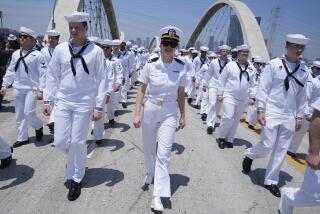WWII battleship to begin transformation into L.A. museum
- Share via
The battleship Iowa, a storied vessel that languished for years in the U.S. Navy’s mothball fleet, is about to start its final journey, from San Francisco to its permanent home as a museum in the Port of Los Angeles.
Next Sunday, four tugboats will guide the Iowa, among the biggest U.S. battleships ever built, under the Golden Gate Bridge and out of the San Francisco Bay. One of them, the 7,200-horsepower Warrior, will chug down the coast with the massive ship in tow, taking three or four days to reach Southern California.
The Iowa’s ultimate destination is San Pedro, where on July 7 it will open to the public for tours and remain as a central attraction on the community’s waterfront.
“In the last century, this was battleship country,” said Robert Kent, director of the Pacific Battleship Center, the group that campaigned to win the Iowa for Los Angeles. “All of our battleships called it home in the period from 1920 to 1940, when Franklin D. Roosevelt sent them to Pearl Harbor to put pressure on the Japanese.”
Launched in 1942, the Iowa was a favorite of President Franklin Delano Roosevelt. It carried him across the Atlantic en route to the 1943 Tehran conference with British Prime Minister Winston Churchill and Soviet leader Josef Stalin. Its bathtub — a rare amenity in a U.S. warship — was installed, along with an elevator, specifically for FDR.
In its heyday, the Iowa’s huge guns could hurl 2,700-pound shells, reaching enemy ships and troops more than 24 miles away. In World War II it fought in the Marshall Islands and off the Philippines. It battered the Japanese island of Hokkaido and was among the Allied ships in Tokyo Bay for Japan’s surrender.
Placed into reserve after the war, it was called back into service for the Korean War and became known as “the gray ghost of the Korean coast.” In eight months, its 16-inch guns lobbed 4,000 shells — twice as many as in World War II.
But critics came to view colossal dreadnoughts as obsolete and too expensive to operate. Aircraft carriers were more efficient, they argued. In 1958, the Iowa was retired again and was idled for the next 26 years. In the 1980s, back in service, it was a formidable presence at NATO exercises and in the Persian Gulf.
The Navy planned to station it permanently in Staten Island, N.Y., but a 1989 gun turret explosion put an end to the controversial plan. The blast killed 47. The Navy at first blamed a sailor allegedly distraught over a failed relationship with another man; it later apologized, saying there was no evidence the explosion was his fault. In 1990, the ship was mothballed for the third and final time.
The Iowa has been tied up at a Richmond, Calif., dock since March. With a 60-foot mast looming over a body more than 15 stories tall, the ship must wait for low tide before passing beneath the Golden Gate Bridge. Even then, according to Kent, it will have less than 20 feet of clearance.
The ship won’t be easy to glimpse on its journey south. It will make the trip about 50 miles out at sea.
“We’ll be well beyond smaller vessels and more conventional traffic,” said Chris Peterson, who oversees tugboat operations for Crowley Maritime, the tug Warrior’s owner. “We’ll have plenty of sea room in case of some emergency.”
It’s not the company’s first time around the block with a battleship. Crowley also moved the Iowa’s sister ships the New Jersey and the Missouri, both now floating museums. In 2001, it towed the Iowa through the Panama Canal — with inches to spare, Peterson said — en route to a fleet of rusting surplus ships in Suisun Bay near San Francisco.
No maneuvers quite as tight are anticipated on the upcoming trip. The biggest challenges will be strong currents in the San Francisco Bay and busy maritime traffic on the Southern California coast, Peterson said.
The unoccupied battleship will be connected to the tug by a tether one-third of a mile long.
For several days, the 45,000-ton Iowa will anchor at a spot three miles off Seal Beach, where divers will scrub the hull of any invasive species it might have picked up. Then it will be towed to a temporary berth in the Port of Los Angeles’ Outer Harbor, awaiting what Kent described as a “grand entry” on June 9, when tugs will tow it the final two miles and into place at San Pedro’s Berth 87. An invitation-only “commissioning ceremony” is set for July 4.
The Pacific Battleship Center raised $5 million to secure the Iowa for Los Angeles, Kent said. The state of Iowa donated $3 million to the effort, which won out over bids from Vallejo, San Francisco and Stockton.
“We’re bringing back to L.A. the last battleship left in the world,” Kent said. “It’s a class of ships that no longer exists, and it’s the last one to go into museum status.”
More to Read
The biggest entertainment stories
Get our big stories about Hollywood, film, television, music, arts, culture and more right in your inbox as soon as they publish.
You may occasionally receive promotional content from the Los Angeles Times.











